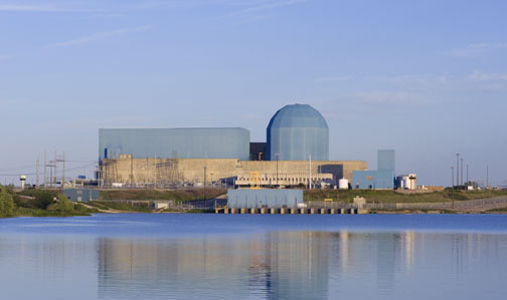By Suzanne Herel, William Opalka and Tom Kleckner
The Environmental Protection Agency’s final Clean Power Plan provoked howls of outrage from coal interests, praise from environmentalists and cautious optimism from regulators and grid operators.
The rule was a mixed bag for the nuclear industry but a win for wind and solar power advocates. Natural gas proponents were miffed by an unexpected change that means they may benefit less than expected from coal’s decline.
On Wall Street, traders punished coal companies while many utility stocks were up modestly.
Below is a summary of the initial reactions to the final rule.
Coal: Rule is Illegal
“Even in the face of damning analyses and scathing opposition from across the country, EPA’s final carbon rule reveals what we’ve said for months: This agency is pursuing an illegal plan that will drive up electricity costs and put people out of work,” said Mike Duncan, president and CEO of the American Coalition of Clean Coal Electricity.

“The administration seems increasingly desperate to salvage an ill-advised and poorly designed rule which won’t work, won’t pass muster with states and won’t stand up to legal scrutiny,” said Deck Slone, Arch’s senior vice president of strategy and public policy.
Regulators, RTOs: Cautiously Optimistic on Reliability Safety Valve
Federal Energy Regulatory Commission Chairman Norman Bay, a Democrat, praised EPA’s “willingness to consider potential reliability concerns and its efforts to address those concerns by adding time and flexibility for compliance, adopting a reliability safety valve and requiring state plans to be reviewed for reliability.”
Republican Commissioner Tony Clark also praised EPA’s engagement but struck a less optimistic view, warning of “the difficult path that now lies ahead.”
“The regulation makes it likely consumers will be required to bear the burden of stranded costs of investments forced to retire years before the useful life of the asset has expired,” he said. “Whatever EPA believes are the environmental benefits of this regulation, it cannot be said that it will be easy or inexpensive. Such is the stuff of unicorns and leprechauns.”
The National Association of Regulatory Utility Commissioners said it would conduct a detailed review to determine how the rules will affect states. “Although NARUC has taken no position on whether the EPA should establish these rules, we have stated that if the agency does issue rules, it should provide states with maximum flexibility to respond,” President Lisa Edgar said.
MISO said it is conducting a regional and state-by-state analysis of the rule. “We will work now on modeling the final rule and run the analysis to help stakeholders better understand compliance options,” the RTO said in a statement.
PJM said it will analyze the reliability safety valve EPA offered in response to grid operators’ concerns.
Environmental Groups Generally Pleased
Environmental groups were generally pleased, though some expressed disappointment with the delay in the initial deadlines, which were pushed from 2020 to 2022.
“For too long the United States has failed to take action on climate change, held hostage by climate deniers in Congress and by industry laggards unwilling to limit pollution that threatens the U.S. and global environment,” Conservation Law Foundation President Bradley Campbell said. “Now we finally have a plan that’s right for our environment and our economy, encouraging states to work together to reduce carbon emissions on a national scale.”
Jordan Stutt, a policy analyst at the Boston-based Acadia Center, said the experience of states participating in the Regional Greenhouse Gas Initiative has shown that a market-based program can reduce CO2 emissions while driving economic growth and innovation. “EPA has recognized this potential for low-cost emissions reductions and has designed the Clean Power Plan in a way that supports widespread implementation of RGGI-like trading programs.”
Allison Clements, director of The Sustainable FERC Project, said the plan “provides states with achievable goals to cut carbon pollution and builds upon the ample flexibilities provided in the original proposal. The final rule’s extra time for initial compliance, requirement that states consider reliability implications and limited ‘reliability safety valve’ put to bed any concerns that the rule will cause grid reliability problems.”
Wind, Solar Celebrate
Renewable energy advocates were quick to praise the plan, with the wind industry saying it could provide a majority of the clean power states will need.

Not to be outdone, the solar industry said that it can provide a 50-state solution.
“Solar energy is the most sensible compliance option for states under the Clean Power Plan. Solar works in all 50 states, has zero carbon emissions, creates more jobs per megawatt than any other technology and can be deployed cost-effectively and quickly — all while improving grid reliability,” said Rhone Resch, CEO of the Solar Energy Industries Association.
Mixed Emotions for Nuclear
The Nuclear Energy Institute said it was pleased that the final rule will count nuclear plants under construction and plant uprates toward compliance rather than the starting point for goal-setting calculations.
“Based on our preliminary review, the final rule appears to require larger carbon reductions than the proposed rule and places a greater emphasis on mass-based compliance approaches. Those two factors alone should drive increased recognition of the value of existing nuclear power plants,” it said.
The group said it was disappointed, however, that EPA did not incorporate the “carbon-abatement value” of existing nuclear power plants.
“EPA notes correctly that ‘existing nuclear generation helps make existing CO2 emissions lower than they would otherwise be but will not further lower CO2 emissions below current levels.’ What the final rule fails to recognize is that CO2 emissions will be significantly higher if existing nuclear power plants shut down prematurely.”
Natural Gas: Half a Loaf
Calpine, the country’s largest generator using natural gas, called the plan “a workable and achievable approach to control CO2 emissions that will benefit generations to come.”
“This flexible, market-based solution will reward the companies that invest and have invested smartly in cleaner generation,” CEO Thad Hill said.
America’s Natural Gas Alliance took issue with changes from the proposed rule that mean natural gas will fill less of the void left by retiring coal generators.
“The White House is ignoring market realities and discounting the ability of natural gas to achieve the objective of emissions reductions more quickly and reliably while powering growth and helping consumers,” said the group, which represents independent gas exploration and production companies. “We believe the White House is perpetuating the false choice between renewables and natural gas. We don’t have to slow the trend toward gas in order to effectively and economically use renewables.”
The Edison Electric Institute said its primary concern “remains the overall timing and stringency of the near-term reduction targets.”
“Until we review the final guidelines in their entirety, it is difficult to assess whether they address the range of concerns we have raised over the past year. Ultimately, it is imperative that the final guidelines respect how the electric system works and provide enough time and flexibility to make the necessary changes to achieve carbon emission reductions.”
Business and Industry Split
Businesses outside the electric industry were split.
Last week, 365 companies and investors sent letters to more than two dozen governors voicing their support for the plan and encouraging the states’ “timely finalization” of implementation plans to meet the new standards.
“Our support is firmly grounded in economic reality,” wrote the businesses, including industry giants such as General Mills, Mars, Nestle, Staples, Unilever and VF Corp. “Clean energy solutions are cost-effective and innovative ways to drive investment and reduce greenhouse gas emissions. Increasingly, businesses rely on renewable energy and energy efficiency solutions to cut costs and improve corporation performance.”
“Having access to clean energy choices, whether efficiency or renewable energy, helps us manage our energy-related costs while also reducing our environmental impact,” said Letitia Webster, senior director of global sustainability at VF Corp., a North Carolina-based apparel company whose brands include The North Face and Timberland.
The American Iron and Steel Institute said, however, that the rule will raise electricity costs for domestic steel companies and threaten the industry’s ability to remain competitive with foreign suppliers.
“The leading steel-producing states in the U.S. are heavily dependent on coal for electricity production. This rule will have a disproportionate impact on coal-fired utilities and, in turn, impede economic growth for steelmakers,” CEO Thomas J. Gibson said.
Gibson added that the domestic steel industry competes with steel producers in countries where energy costs are often subsidized. “Limitations on CO2 emissions instituted in the U.S. must also apply at the same level of stringency to other major steel-producing nations, such as China. Otherwise, steel production and manufacturing jobs will shift to other nations with higher rates of greenhouse gas emissions.”
Stock Market
While the Dow Jones Industrial Average closed down 91.66 points (a 0.52% drop), electric utility stocks generally fared well. Nuclear-heavy Exelon was up 1.1%, while coal-dependent companies fared slightly worse, with Duke Energy gaining 1%, American Electric Power up 0.85%, Southern Co. up 0.51% and Entergy up 0.4%.
Not unexpectedly, major coal companies suffered through a tough Monday. Arch Coal saw its shares drop from $1.80 to 18 cents, while Peabody Energy was down 9.2%. Consol Energy, a coal, oil and natural gas company with a mining business focused in the Appalachian Basin, dropped 7.6%.

